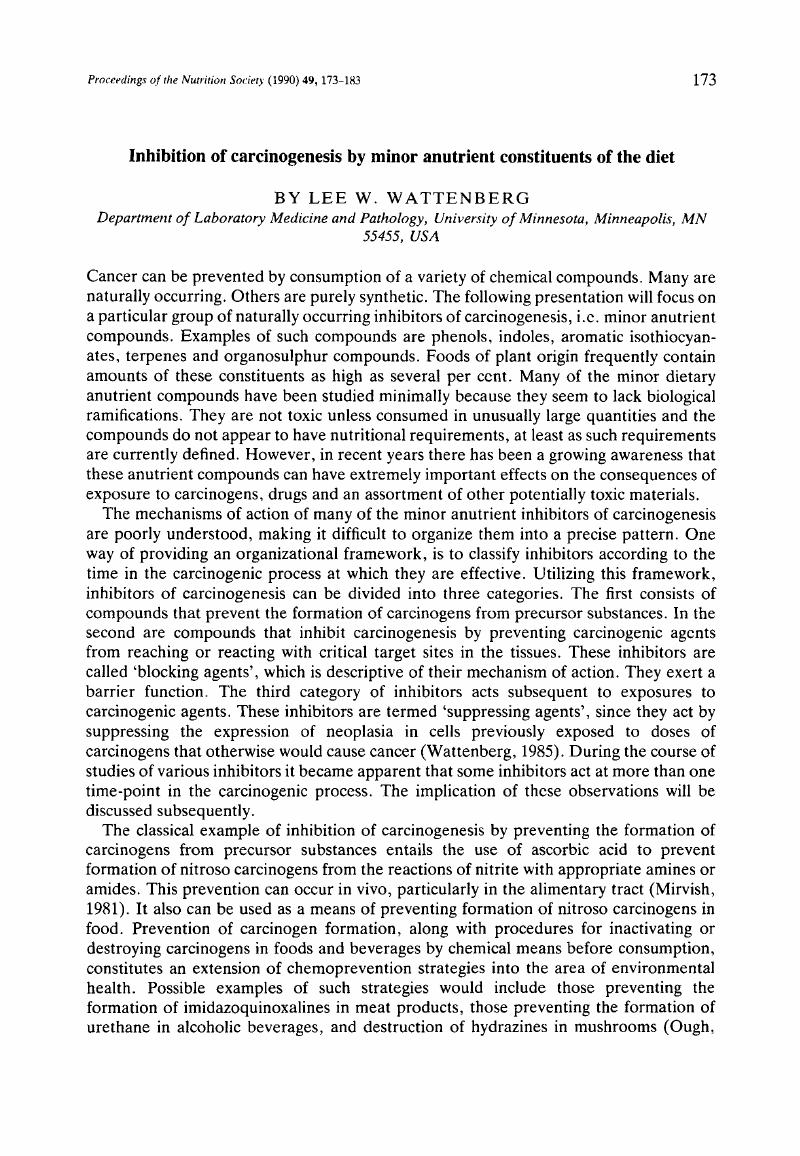Crossref Citations
This article has been cited by the following publications. This list is generated based on data provided by Crossref.
Bingham, Sheila A.
1990.
Mechanisms and experimental and epidemiological evidence relating dietary fibre (non-starch polysaccharides) and starch to protection against large bowel cancer.
Proceedings of the Nutrition Society,
Vol. 49,
Issue. 2,
p.
153.
Spiller, GA
1991.
Beyond dietary fiber.
The American Journal of Clinical Nutrition,
Vol. 54,
Issue. 4,
p.
615.
Clemens, M. R.
1991.
Free radicals in chemical carcinogenesis.
Klinische Wochenschrift,
Vol. 69,
Issue. 21-23,
p.
1123.
Block, Eric
1992.
Die Organoschwefelchemie der Gattung Allium und ihre Bedeutung für die organische Chemie des Schwefels.
Angewandte Chemie,
Vol. 104,
Issue. 9,
p.
1158.
Block, Eric
1992.
The Organosulfur Chemistry of the Genus Allium – Implications for the Organic Chemistry of Sulfur.
Angewandte Chemie International Edition in English,
Vol. 31,
Issue. 9,
p.
1135.
Elson, Charles E
and
Yu, Suzanne G
1994.
The Chemoprevention of Cancer by Mevalonate-Derived Constituents of Fruits and Vegetables.
The Journal of Nutrition,
Vol. 124,
Issue. 5,
p.
607.
Greenwald, Peter
1994.
Experience from Clinical Trials in Cancer Prevention.
Annals of Medicine,
Vol. 26,
Issue. 1,
p.
73.
Beecher, CW
1994.
Cancer preventive properties of varieties of Brassica oleracea: a review.
The American Journal of Clinical Nutrition,
Vol. 59,
Issue. 5,
p.
1166S.
O’Brien, Peter J.
1994.
Free Radicals in Diagnostic Medicine.
Vol. 366,
Issue. ,
p.
215.
Musk, Stephen R. R.
Stephenson, Pauline
Smith, Tracy K.
Stening, Peter
Fyfe, Daren
and
Johnson, Ian T.
1995.
Selective toxicity of compounds naturally present in food toward the transformed phenotype of human colorectal cell line HT29.
Nutrition and Cancer,
Vol. 24,
Issue. 3,
p.
289.
Singh, Anjali
and
Rao, A. R.
1995.
Evaluation of the modifying influence of arecanut on the garlic‐modulated hepatic detoxication system enzymes, sulfhydryl content, and lipid peroxidation in mice.
Teratogenesis, Carcinogenesis, and Mutagenesis,
Vol. 15,
Issue. 3,
p.
127.
Yu, Suzanne G.
Hildebrandt, Leslie A.
and
Elson, Charles E.
1995.
Geraniol, an Inhibitor of Mevalonate Biosynthesis, Suppresses the Growth of Hepatomas and Melanomas Transplanted to Rats and Mice.
The Journal of Nutrition,
Vol. 125,
Issue. 11,
p.
2763.
Langman, J. M.
1995.
d-Limonene: Is It A Safe, Effective Alternative to Xylene?.
Journal of Histotechnology,
Vol. 18,
Issue. 2,
p.
131.
von Burg, R.
1995.
Limonene.
Journal of Applied Toxicology,
Vol. 15,
Issue. 6,
p.
495.
Smith, Stephanie A.
Campbell, Deborah R.
Elmer, Patricia J.
Martini, Margaret C.
Slavin, Joanne L.
and
Potter, John D.
1995.
The University of Minnesota Cancer Prevention Research Unit vegetable and fruit classification scheme (United States).
Cancer Causes and Control,
Vol. 6,
Issue. 4,
p.
292.
Newmark, Harold L.
1996.
Dietary Phytochemicals in Cancer Prevention and Treatment.
Vol. 401,
Issue. ,
p.
25.
Ohnishi, Masami
Tanaka, Takuji
Makita, Hiroki
Kawamori, Toshihiko
Mori, Hideki
Satoh, Kumiko
Hara, Akira
Murakami, Akira
Ohigashi, Hajime
and
Koshimizu, Koichi
1996.
Chemopreventive Effect of a Xanthine Oxidase Inhibitor, 1′‐Acetoxychavicol Acetate, on Rat Oral Carcinogenesis.
Japanese Journal of Cancer Research,
Vol. 87,
Issue. 4,
p.
349.
AlDosari, Abdullah
McDonald, James
Olson, Byron
Noblitt, Tim
Li, Yiming
and
Stookey, George
1996.
Influence of benzylisothiocyanate and 13-cis-retinoic acid on micronucleus formation induced by benzo[a]pyrene.
Mutation Research/Fundamental and Molecular Mechanisms of Mutagenesis,
Vol. 352,
Issue. 1-2,
p.
1.
GOPALAN, C.
1997.
Dietetics and Nutrition.
Journal of the American Dietetic Association,
Vol. 97,
Issue. 7,
p.
737.
Crozier, Alan
Lean, Michael E. J.
McDonald, Morag S.
and
Black, Christine
1997.
Quantitative Analysis of the Flavonoid Content of Commercial Tomatoes, Onions, Lettuce, and Celery.
Journal of Agricultural and Food Chemistry,
Vol. 45,
Issue. 3,
p.
590.



